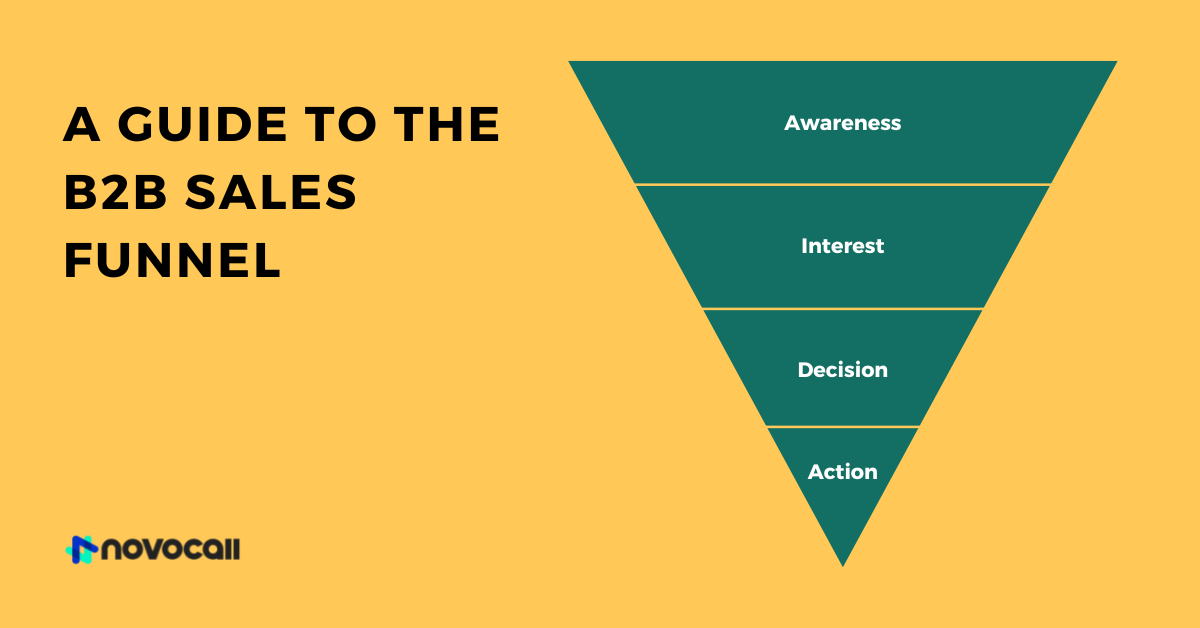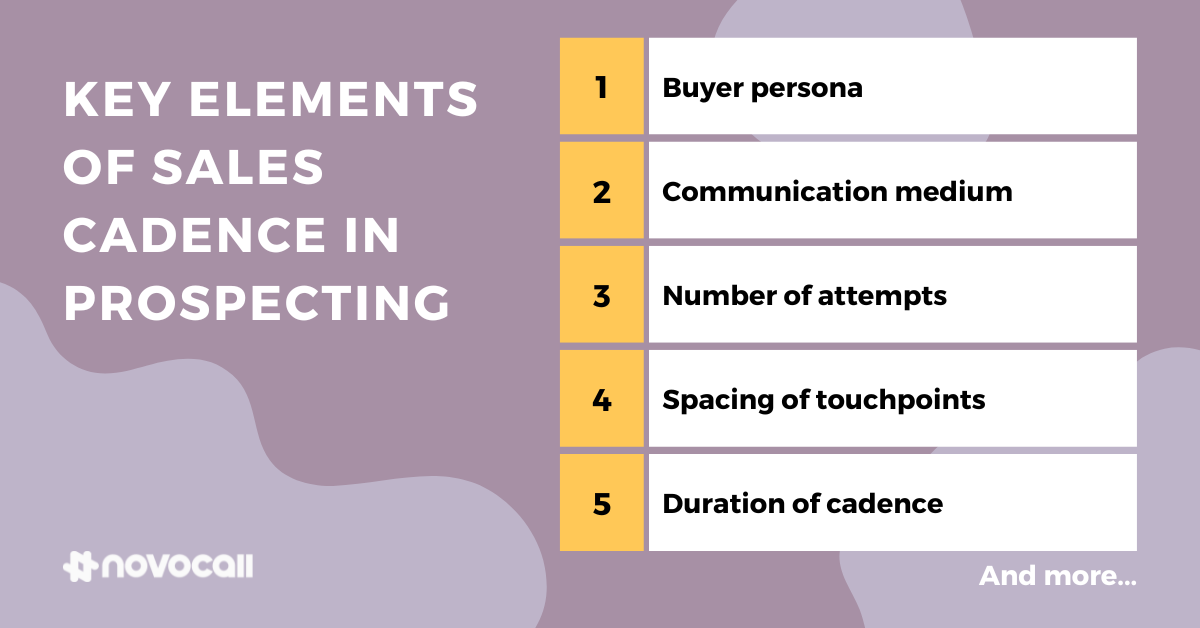


Start driving better conversations.
Novocall will be your new favorite business phone system.

Prospecting is essential to all businesses because it creates opportunities to sell more. If done correctly, it will help develop a pipeline of potential customers that sales representatives can tap to close deals.
However, prospecting is more than just approaching people and giving a pitch. Careful planning and execution are vital when it comes to engaging potential clients. With practices like a sales cadence, prospecting becomes more efficient and yields excellent results.
Generally, cadence is a term used to describe rhythm or tempo. In prospecting, it refers to the sequence of efforts that sales reps make when connecting with potential clients.
It involves a series of strategic interactions across different channels, including sending emails and making phone calls. This practice allows sales reps to gain more prospects and close deals quickly.
Keep reading below to learn more about sales cadences and how to do it properly.
Establishing a rhythm during prospecting allows sales reps to overcome challenges quicker when they come. With this, they can maintain communication with their leads, which increases their chances of conversions.
A sales cadence offers a more structured approach to prospecting. Without it, sales reps could impulsively send out emails or make phone calls to potential clients.
Unfortunately, doing so could hurt their chances of getting a sale. Having a better structure means approaching prospects carefully, leading to better connections and, eventually, closed deals.
Tracking your sales progress is easier once you establish a more organized cadence. That means you can monitor and modify your plan based on factors like prospect response.
Effective sales cadence enables your company to predict how and when your leads will turn into sales. With this, the management will be able to plan more realistically. For instance, forecasting sales allows them to budget better for future plans.
Setting a standardized procedure allows your company to grow fast with fewer issues. For instance, new sales reps can adopt current cadences to maintain consistency and ensure more sales.
Meanwhile, businesses can also expand their sales leads without increasing their workforce. Using the same effective cadence enables sales reps to become more efficient in the field. Because of this, they can handle and close multiple deals simultaneously.
Creating a buyer persona is vital in developing a sales cadence strategy. It helps you understand your target market and their industry, contact methods, and buying behaviors. It also enables you to craft specific cadences depending on these profiles.
For instance, your strategy for C-level executives differs from entry-level employees.
Generally, a buyer persona is a detailed profile representing a particular target market. By combining research-based data and educated assumptions, sales reps can form such an identity.
Some vital factors you need to consider when creating this include demographics, lines of work, and challenges while buying.
A good sales cadence combines a variety of communication channels to tap potential buyers. These include emails, phone calls, text messages, and social media networks.
The key to choosing the right combination will depend on a predetermined persona. Identify which channels they are mostly active on and maximize it.
A sales cadence involves tapping the potential buyer strategically. The main reason for having a limited number of attempts is to avoid annoying your prospects and hurting your chances.
Plus, it’s to set a limit to save time instead of chasing dead-end leads. With that, the ideal number of attempts during your whole sales cadence should be eight to 12.
Using your number of attempts daily will only drive away your potential clients. They need time and space to think through your offer and decide.
The spacing between touchpoints is vital. Ideally, you must give two days before contacting your prospects again.
Duration refers to the length of your sales cadence, from the first touchpoint to the last. The standard length should be around two to four weeks, depending on the prospect’s response.
For instance, getting no reaction from your prospects means you can stop pursuing them after two weeks. However, if you find that they’re opening emails or clicking links, you can go on with your cadence plan. You just need to adjust your strategy.
Categorizing your potential clients helps create a more specific cadence for each group. Doing this is vital if your business caters to different audiences. So, you must space your cadence and use specific communication channels depending on various categories.
These include personas, industries, and locations.
Content is the driving force behind an effective sales cadence. The key is to use your potential client’s pain points to ignite their curiosity. Your copy should also be informative and tell them how your product or service can help them.
It also helps to personalize your messages, from the subject line to your email’s body. You should also provide actionable elements like contact information, social media profiles, and website links.
The first few tries of your sales cadence may be challenging because you’re basing it on a buyer persona. When executing your strategy, you must collect as much helpful data about your prospects as possible. Doing this will help you make tweaks that gear towards a more realistic prospect profile.
The best thing about sales cadence is that it’s customizable. Sales reps can create their own depending on buyer personas and other factors. Below is one of the best examples that you can use today.
Start by looking for your potential client’s email address. LinkedIn is an excellent place to start since it’s a professional social media platform.
Before sending a message, learn more about your prospect’s business. You can request a connection on LinkedIn and go through their profile or visit their website for more helpful information. The key is to look for issues that your products and services can fix.
When drafting an email, you should acknowledge your prospect’s position and business before introducing your products and services. Then, provide a brief detail on how your company can help them.
This part of your sales cadence is where you empathize with the prospect’s pain points. Use real-life cases of past clients and elaborate on how your products and services helped them. You can use their known competitors to help boost your credibility. However, ensure that the ones you use are those you’ve made deals with in the past.
At the end of your message, ask them if they can spare you a few minutes of their time. You can offer a phone call to elaborate further.
Send your first follow-up email if your prospects haven’t responded to your initial offer. Since you’ve already provided them with an informative message, this one should be short and straightforward. That means it should only aim for a simple “yes” or “no” answer from its recipient.
For instance, ask them if they’re open for a quick phone call or message exchange via email or LinkedIn. Find out if they want to move forward with learning more about products and services.
Make the first follow-up call to your prospect, preferably at night. If the potential client doesn’t pick up, leave a voicemail with your name, phone number, and company info. Then, request a callback at the prospect’s immediate convenience.
You should also send an email referring to your phone call attempt and voicemail.
Your second follow-up email should offer more detailed information about the features of your offerings. Always make sure that you include your prospect’s pain points in this message.
Provide more case studies on how your products and services helped other businesses. Try to prioritize stories related to your prospect’s competitors. Including them will enable the potential client to visualize your solution better. Plus, it helps boost your reliability.
This email is the last attempt in your communication chain. Again, highlight your prospect’s pain points and how your business can help them. Despite being the final message, ensure that you end positively. Doing this will give the impression that you’re always open to helping out.
As explained, a sales cadence is one of the best practices that can turn leads into closed deals. It’s a strategic approach to prospecting that enables sales reps to engage their potential clients more professionally.
The best thing about this practice is that sales reps can customize theirs depending on the prospect’s profession and buying behavior. You can adapt and test various cadences until you discover what works best for you.

Ivan Serrano is an enthusiastic writer who enjoys learning whatever he can about business development and growth hacking. He also enjoys sharing his knowledge of technology and how it can improve business communications on an international level.
Related articles
Subscribe to our blog
Get insights & actionable advice read by thousands of professionals every week.

